Overview
-
Buried TeaBowl – OKUNI
New work by Australia's leading Japanese artist and dancer Yumi Umiumare, "Buried TeaBowl - OKUNI" was presented at BLACKCAT GALLERY in 2022. This intimate yet grand solo performance installation combines dance, butoh, theatre, song and tea ceremony, with a stunning video (produced by Takeshi Kondo) that was filmed during the COVID-19 lockdown. The piece explores the life of Izumo no Okuni, a historical Japanese dancer and shrine maiden from the early 1600s, who is credited with founding kabuki theatre but remains an enigmatic figure. Umiumare's contemporary interpretation of Okuni appears in various forms, moving between the real and the surreal, drawing the audience into a world of dreams and fantasy.
While evoking the "myths" and power of invaluable women buried in history, Umiumare's unique narrative and humour in "Buried TeaBowl - OKUNI" bring forth a punkish, feminine, and liberated Okuni - one that speaks to the needs of the present day.
- OzAsia Festival 2023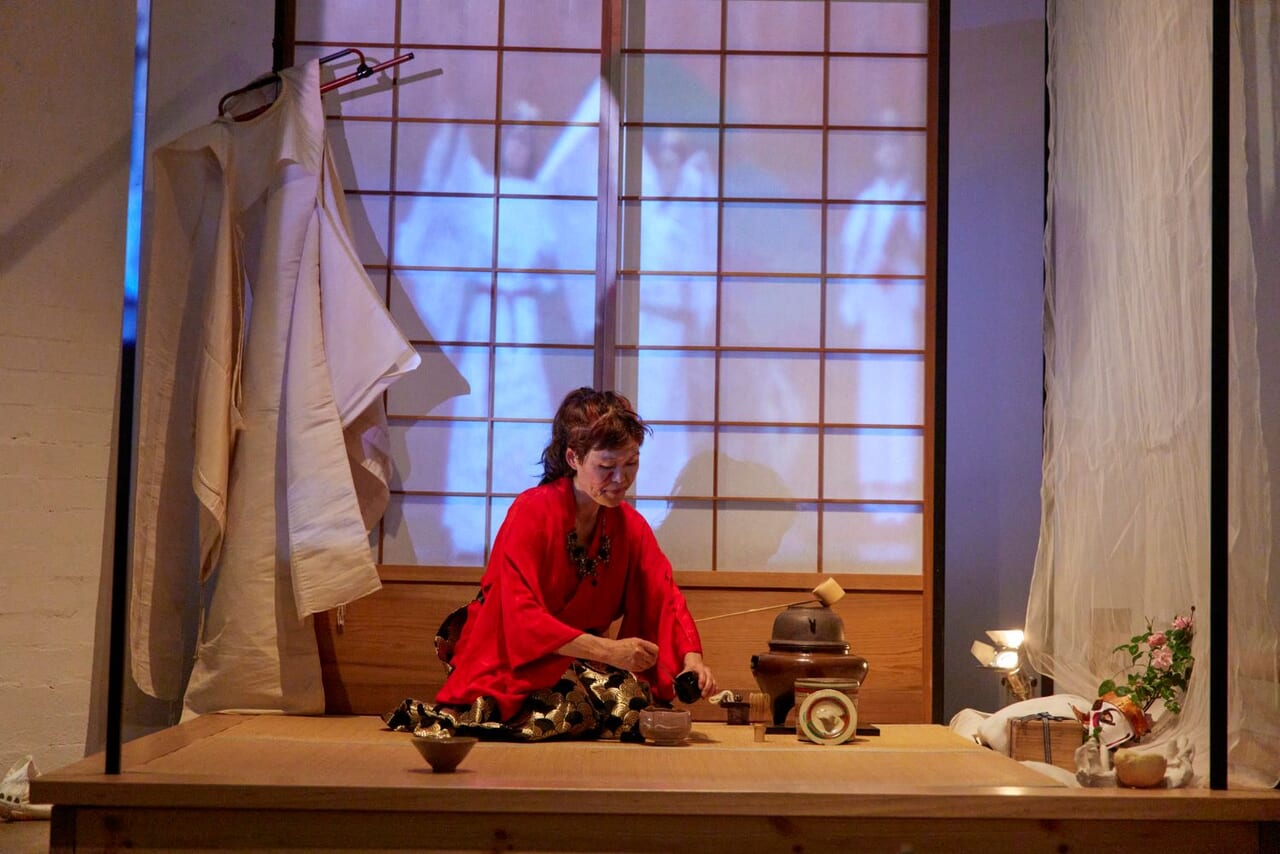
- Performer(s)
- Yumi Umiumare
- Director/Choreographer
- Yumi Umiumare
- Venue
- BLACKCAT Gallery (Sol Gallery)
- Year performed
- 2022
-
Bravos Pioneiros; Cançao da Alegria [Songs of Joy]
"Bravos Pioneiros": Struck by the sight of the Issei pioneers' tanned, muscular bodies, intense gazes, and white beards - a human presence unlike anything she had encountered before - Akiko Ohara felt as though she were witnessing a living masterpiece. This work was created in response to the striking beauty of these workers at their labour.
"Canção de Alegria" [Songs of Joy]: Akiko Ohara recalls her excitement upon arriving at Yuba Farm, followed Yuba theme songs sung in a chorus (lyrics and music by Masakatsu Yazaki), including "Porque o sol é quente" [Because the Sun is Hot], "Os companheiros do yuba" [Friends of Yuba], and "Canção de Alegria" [Song of Joy]. As with "Bravos Pioneiros", this piece captures life on Yuba Farm and has been performed numerous times.
"Bravos Pioneiros" premiered in 1963, and "Cançao de Alegria" [Songs of Joy] premiered in 1978. Both works were performed at Yuba Farm, in Japan and throughout Brazil. Commemorating the 70th anniversary of Japanese immigration to Brazil, the programme for Ballet Yuba's first tour of Japan in 1978 across 13 venues began with "Bravos Pioneiros" and ended with "Cançao de Alegria" [Songs of Joy], which was created specially for the tour. "Cançao de Alegria" [Songs of Joy] was edited in 2021.![Bravos Pioneiros; Cançao da Alegria [Songs of Joy]](https://video.dance-archive.net/en/wp-content/uploads/2025/01/P005246_14498.jpg)
- Performer(s)
- Ballet Yuba
- Director/Choreographer
- Akiko Ohara
- Venue
- Teatro Yuba
- Year performed
- 2021
-
Brandenburg Concerto and 5 short pieces
British choreographer Anton Dolin said he had never seen anything like it, claiming that the music by Bach must have written for this piece; that was the effect of Midori Ishii's Brandenburg Concerto. Ishii's particular way of finding rhythm - moving from 'hold' (off-beat), having 'stolen sounds' and being 'still in the midst of movement' - these are also traditionally Japanese ways of finding rhythm. This is one of Ishii's signature pieces, which exemplifies these ideas.
-The first section of Midori Ishii's 50 Years of Dance anniversary performance, including Brandenburg Concerto, and five short pieces: 'Southern Moon' (6'22"") / 'Golliwog's Cakewalk' (2'22"") / 'Udaru' (5'32"") / 'Three Themes' (0'32"") / 'Four Walls' (7'35"") / 'Brandenburg Concerto' (18'33"")
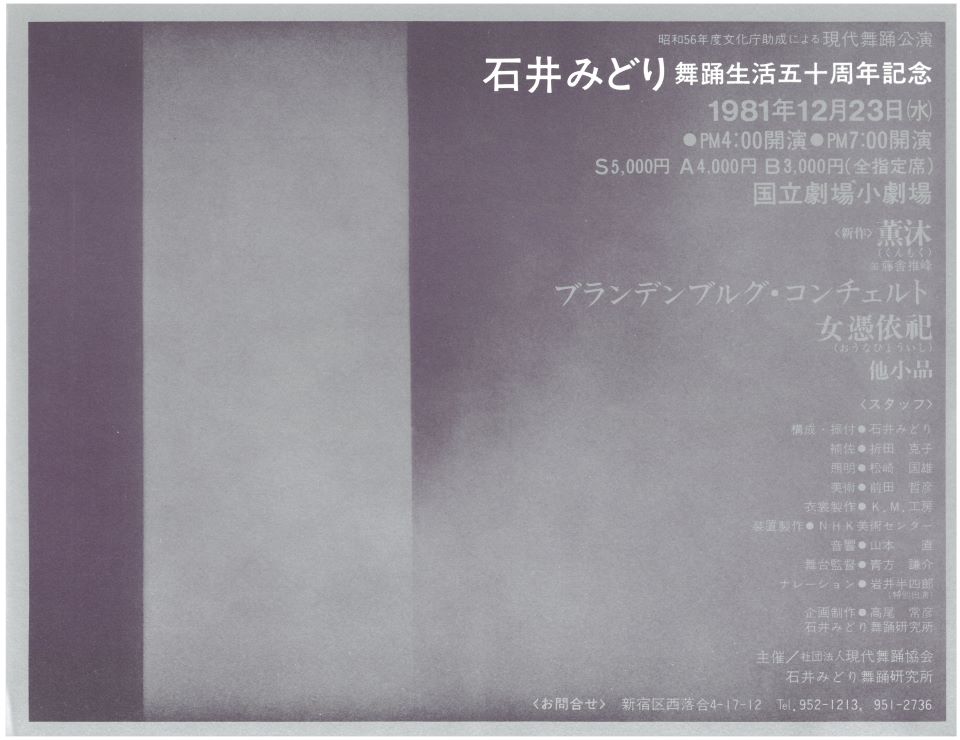
- Performer(s)
- Midori Ishii and Katsuko Orita Dance Studio
- Director/Choreographer
- Midori Ishii
- Venue
- National Theatre of Japan : Small Theatre
- Year performed
- 1981
-
A Body with Fukushima
Since 2014, Eiko Otake has visited Fukushima several times with historian and photographer William Johnston, performing without an audience and recording them on camera. This is a 25 minute edit of a performance that Otake did while projecting a one hour video compilation of photographs taken over five trips to Fukushima onto the walls of a theatre. The present, past and landscape of post-earthquake Fukushima are presented through her body.
Projection: 'A Body in Fukushima' (Photography: William Johnston / Editing: Eiko Otake / Music: David Harrington Kronos Quartet)
-Eiko Otake Project - A Body in Places
-Tokyo Real Underground (Tokyo Tokyo FESTIVAL Special 13): 1 April - 15 August 2021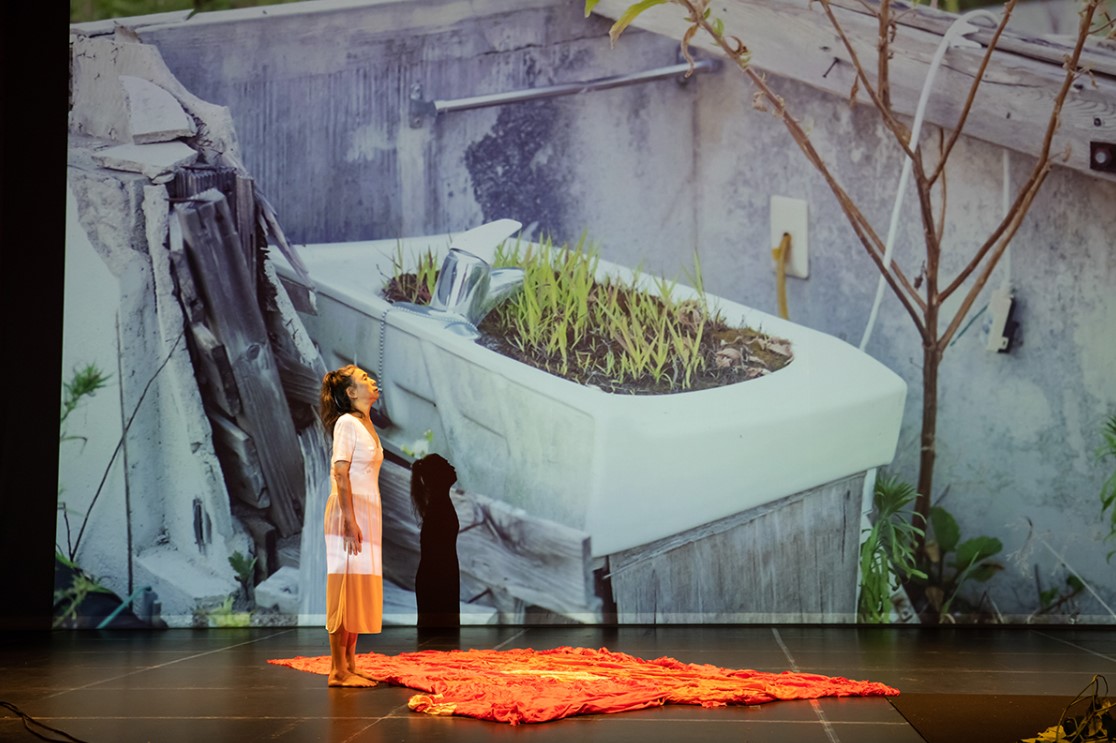
- Performer(s)
- NPO Dance Archive Network
- Director/Choreographer
- Eiko Otake
- Venue
- Filmed at the Tokyo Metropolitan Theatre : Theatre East
- Year performed
- 2021
-
Tai [Body]
Midori Ishii's choreography to Stravinsky's 'The Rite of Spring' is not the usual story of sacrifice, but rather uses themes that the famed piece inspired in Ishii: nature and vitality. The dancers' interplay of curves and straight lines, feet shifted by the centre of gravity and stillness in motion are excellent, and the expression captured by their bodies in the final chapter is a beautiful hymn to humanity.
-Presented at the Midori Ishii Dance Recital as Ishii Midori Dance Works Vol. 2.
-Premiered in 1961, this version was performed in 1983. Awarded the Art Encouragement Prize in April 1962. Katsuko Orita, was awarded the first Art Festival Individual Performance Award for Modern Dance with this piece. It was performed again in 2015 and 2018 at the Dance Archive Performances organised by the Contemporary Dance Association of Japan, and hailed as a powerful and dynamic work.![Tai [Body]](https://video.dance-archive.net/en/wp-content/uploads/2024/01/V00024_ishiiorita1s_fl.jpg)
- Performer(s)
- Midori Ishii and Katsuko Orita Dance Studio
- Director/Choreographer
- Midori Ishii
- Venue
- Tokyo Post Saving Hall
- Year performed
- 1983
-
Kim Ito’s ‘Body Story’ and Takeshi Yazaki’s ‘Meat Excuses’
'Body Story' - The fascinating changes, the many different textures that can appear and disappear from a single body; mechanical and rigid, movements smooth as water, drifting like air... A strong solo improvisation piece that fully incorporates the sharp, flowing movements unique to Ito Kim.
'Meat Excuses' - Reason and instinct, laughter and anger, tension and relaxation, seriousness and frivolity, the self and non-self, artistry and entertainment. A tragicomic story of a piece of meat in various repeated battles.
- Participated in the 4th OSAKA DANCE EXPERIENCE Dance Battle - Before Dance / After Dance - Kim Ito x Takeshi Yazaki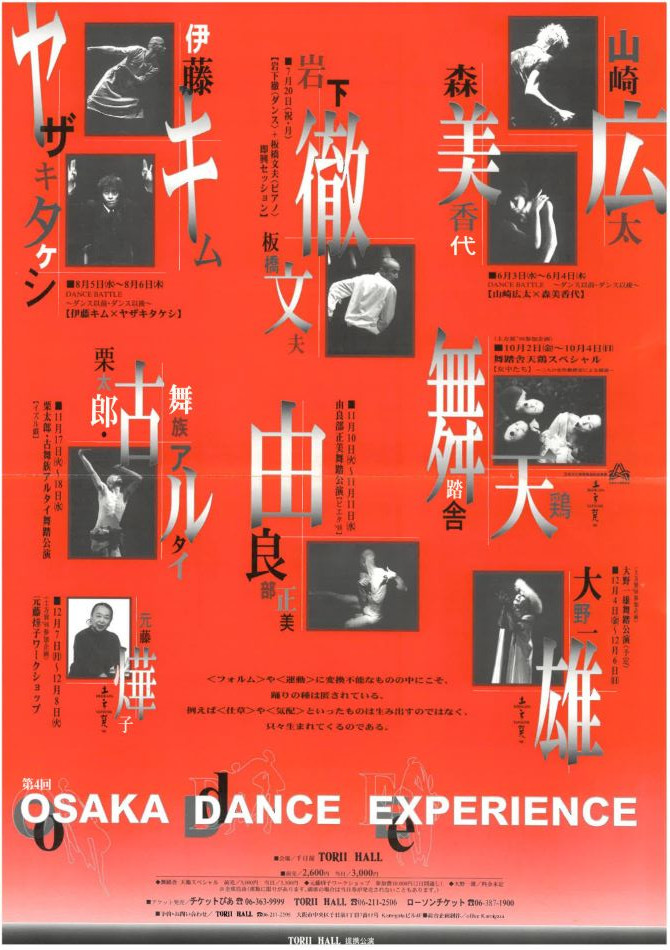
- Performer(s)
- TORII HALL
- Director/Choreographer
- Kim Ito, Takeshi Yazaki
- Venue
- TORII HALL
- Year performed
- 1998
-
A Body in Tokyo
Eiko Otake, based in the United States since 1976, is a highly regarded artist who has performed in many countries as part of the performance duo Eiko & Koma. Her solo project "A Body in Places", which has attracted much attention since beginning in 2014, is performed for the first time in Japan. Ten years since the Great East Japan Earthquake, Otake places herself in different spaces around the Ueno area in Tokyo (Ueno Station, Tokyo Bunka Kaikan, Nakacho Shopping Street, etc.), and in underground spaces of the Former Hakubutsukan Dobutsuen Station and Shibuya River culvert, layering projected images of Fukushima onto the surrounding buildings and herself.
Created as a video piece. The work was available for online viewing from its release date until the conclusion of the Tokyo Real Underground festival (1 April - 15 August 2021).
Film locations: Ueno area / Former Hakubutsukan Dobutsuen Station / Shibuya River culvert
Projection: 'A Body in Fukushima' (Photography: William Johnston / Editing: Eiko Otake / Music: David Harrington Kronos Quartet)
-Eiko Otake Project - A Body in Places
-Tokyo Real Underground (Tokyo Tokyo FESTIVAL Special 13)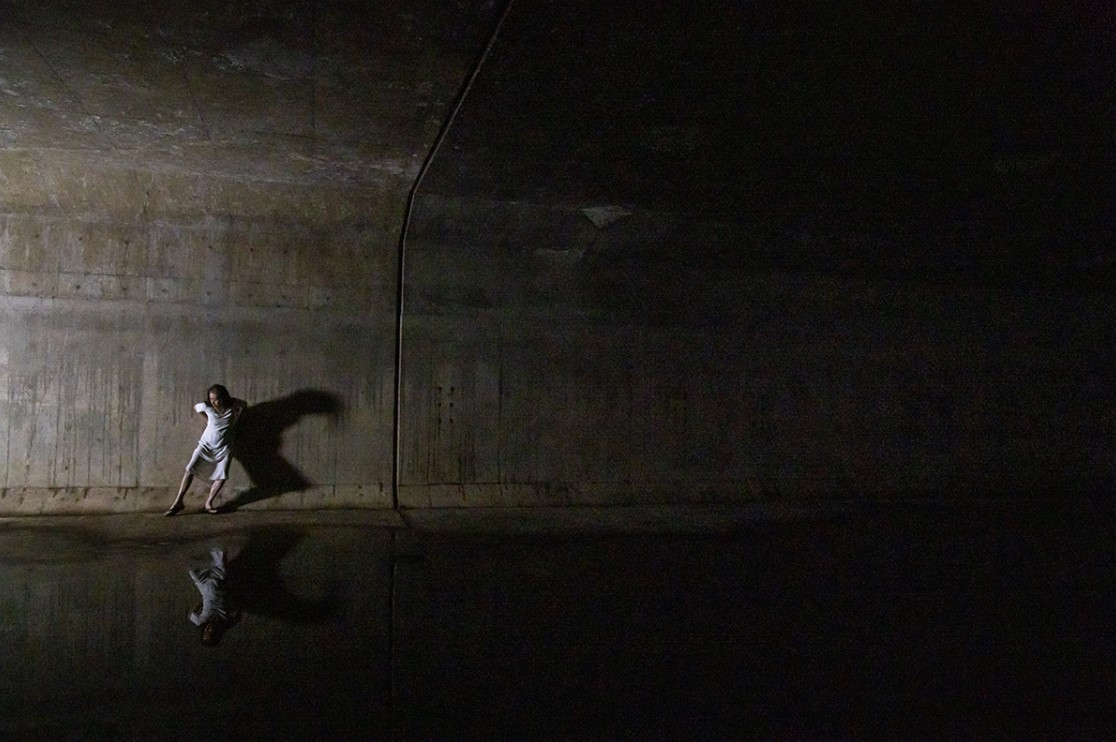
- Performer(s)
- NPO Dance Archive Network
- Director/Choreographer
- Eiko Otake
- Year performed
- 2021
-
Blue Sky Dancer: Gilyak Amagasaki
Street performer Gilyak Amagasaki danced all over the world in what he called 'Blue Sky Dance Performances'. These began with performances that were held almost every autumn from 1978 in an outdoor square of the Mitsui Building, in the skyscraper district of Shinjuku, Tokyo. This video shows the entire performance of 13 October 2002. In it, Gilyak indicates a cloth on which the title is written and explains to the audience what is to be performed, then proceeds to dance. There was no charge for the performance, but the audience was encouraged to pay donations. The video shows the audience helping Gilyak collect money thrown on the ground after the performance.
- Performer(s)
- Gilyak Amagasaki
- Director/Choreographer
- Gilyak Amagasaki
- Venue
- Shinjuku Mitsui Building Hiroba
- Year performed
- 2002
-
BLOOM
Premiered at the Edinburgh Fringe Festival in August 1996.
Received a number of rave reviews including: 'a totally electrifying experience' (The Stage), 'makes you think about the beauty and meaningfulness of movement' (The Scotsman).
It has been since been developed and refined, and performed in many places across Japan, and become one of Gekidan Taihen's key works."
- Tobita Theatre Performance Award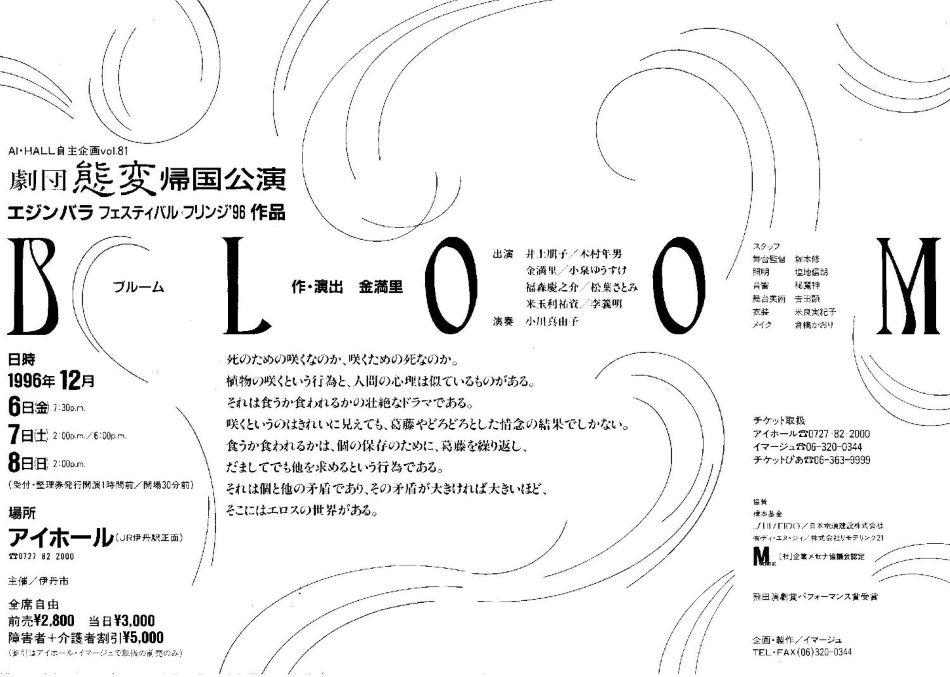
- Performer(s)
- Performance Troupe TAIHEN
- Director/Choreographer
- Manri Kim
- Venue
- AI Hall (Itami City Theater Hall)
- Year performed
- 1996
-
Blanc Whispering muttering
White paper folded into human figures, by artist Claudine Drai, are grouped together and displayed around the stage as though it were a museum. Some are covered in a smoke-coloured powder.
They resemble people caught in the midst of war.
Suddenly, three dancers dressed in white emerge as though they've leapt out of the display. They walk, leap, roll, and at times dance in unusual forms. A woman dressed in black wanders around, seemingly cast out of the world, lost and abandoned.
They cross paths, meet, and drift apart. Where is the world heading?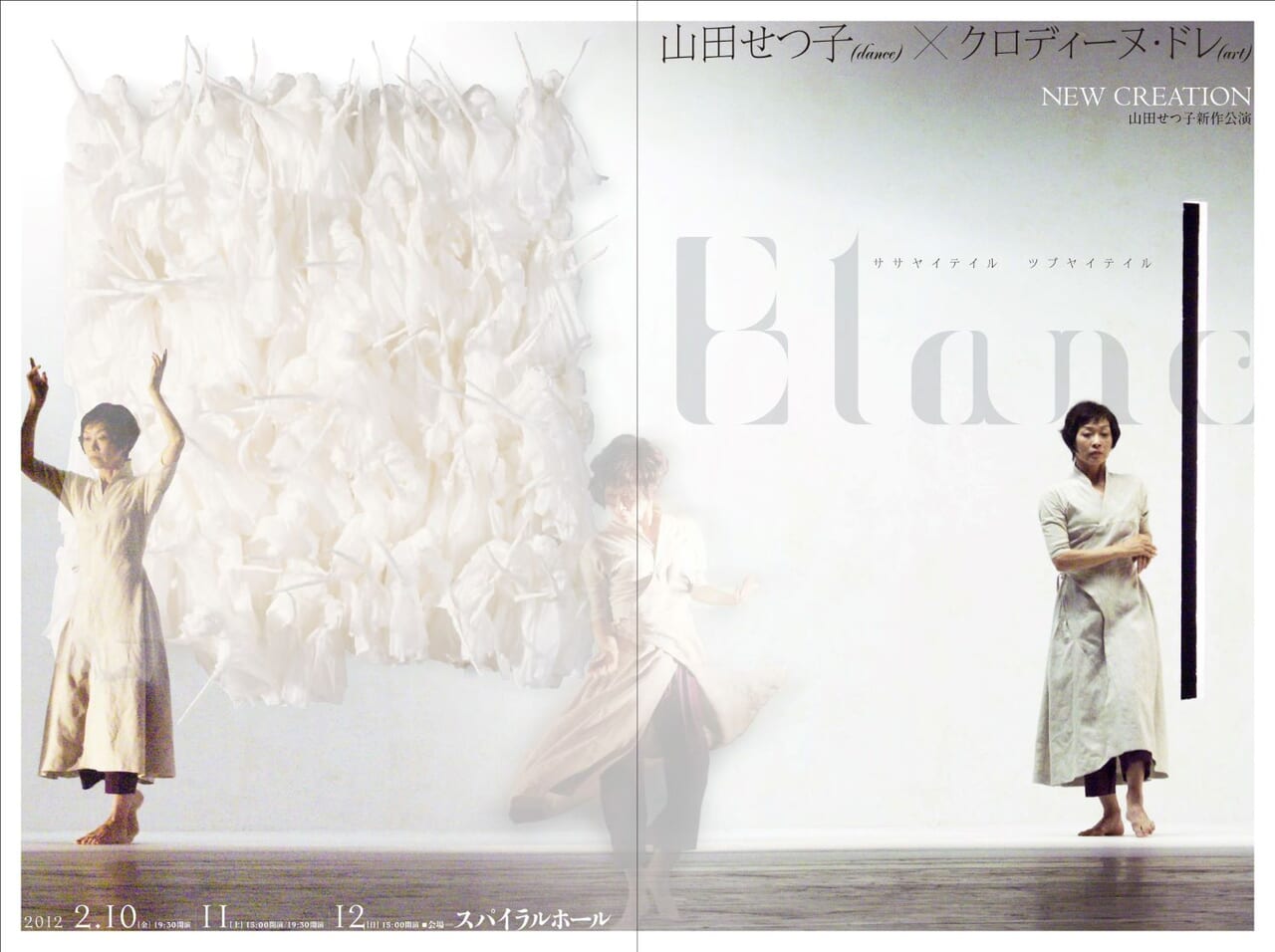
- Performer(s)
- Setsuko Yamada
- Director/Choreographer
- Setsuko Yamada
- Venue
- Spiral Hall
- Year performed
- 2012
-
Bite
"Atsugi Bonjin's first performance on returning to Japan after studying in New York. The work had four chapters, and the following words were included in the programme:
By a luxurious and desolate display window, as Life is swept away / The frozen glass of the display window
Life's conscious mind / As limescale breaks free and / Escapes
To Bite is / to Kill / to Bite / to Chew and / as Chewing continues Wear clothes, sit on a chair and / Wipe the mouth with a napkin"
-First Dance Critics Society Award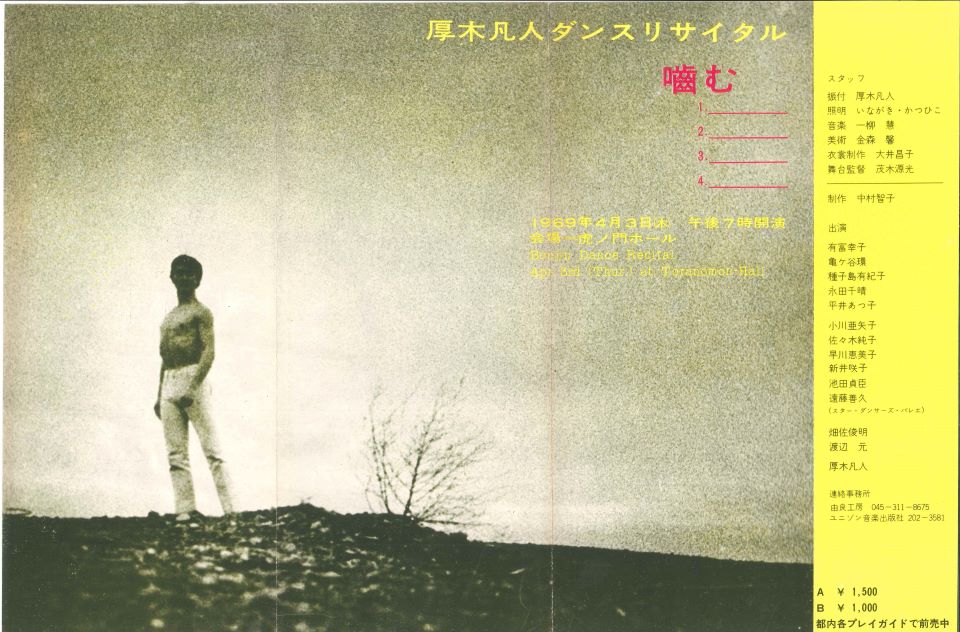
- Performer(s)
- Bonjin Atsugi
- Director/Choreographer
- Bonjin Atsugi
- Venue
- Toranomon Hall
- Year performed
- 1969
-
Bird Woman’s Head (reproduction)
One of the four part 'Funeral Series' performed by Yoshitmoto Daisuke in the 1980s. This 'Bird Burial' was the final part of the series, following 'Wind Burial - Fern in the Wind', 'Cremation - Egg in the Fire' and 'Water Burial - Stone at the Bottom of the Water'. After performances in Poland and Switzerland, it was performed again later in Tokyo. Original concept: 'Stanislav de Gala Soshaku Kōfujin' [Madame de Stanislav de Gala Mastication].
On the flyer are word by Comte de Lautréamont: Gravedigger, it is beautiful to contemplate the ruins of the cities; but it is more beautiful to contemplate the ruins of humans!
- Daisuke Yoshimoto Butoh Dance
- Invited to the 3rd International Contemporary Festival in Lausanne, 1992
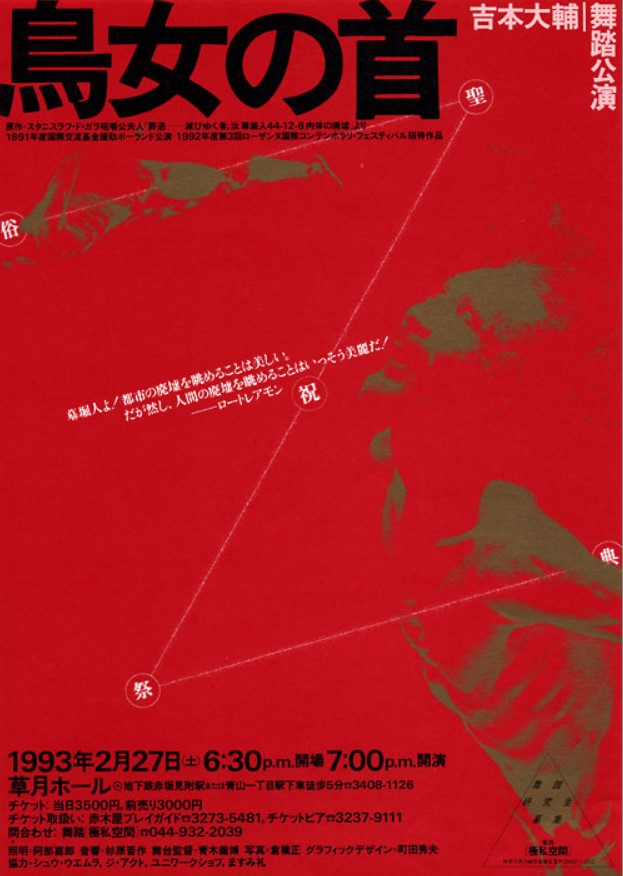
- Performer(s)
- Daisuke Yoshimoto
- Director/Choreographer
- Daisuke Yoshimoto
- Venue
- Sogetsu Hall
- Year performed
- 1993
-
Bird: Fantastical Thoughts – Garden of Eve II
The work, in which 'for much the performance the dancer moves from right to left along the two black walls intersecting at a right angle', evokes for the viewer a 'movement in stillness' and 'exudes a forceful energy, reminiscent of a bird attempting to stretch its wings and fly to the heavens, but unable to do so' (Denzaburo Yoshizawa, Modern Thought). This work was inspired by the words of Roger Caillois, 'illusion first and foremost means anxiety and destruction'.
-Uesugi Mitsuyo Butoh Performance
-The above quotations are taken from the January 1983 issue of Modern Thought magazine.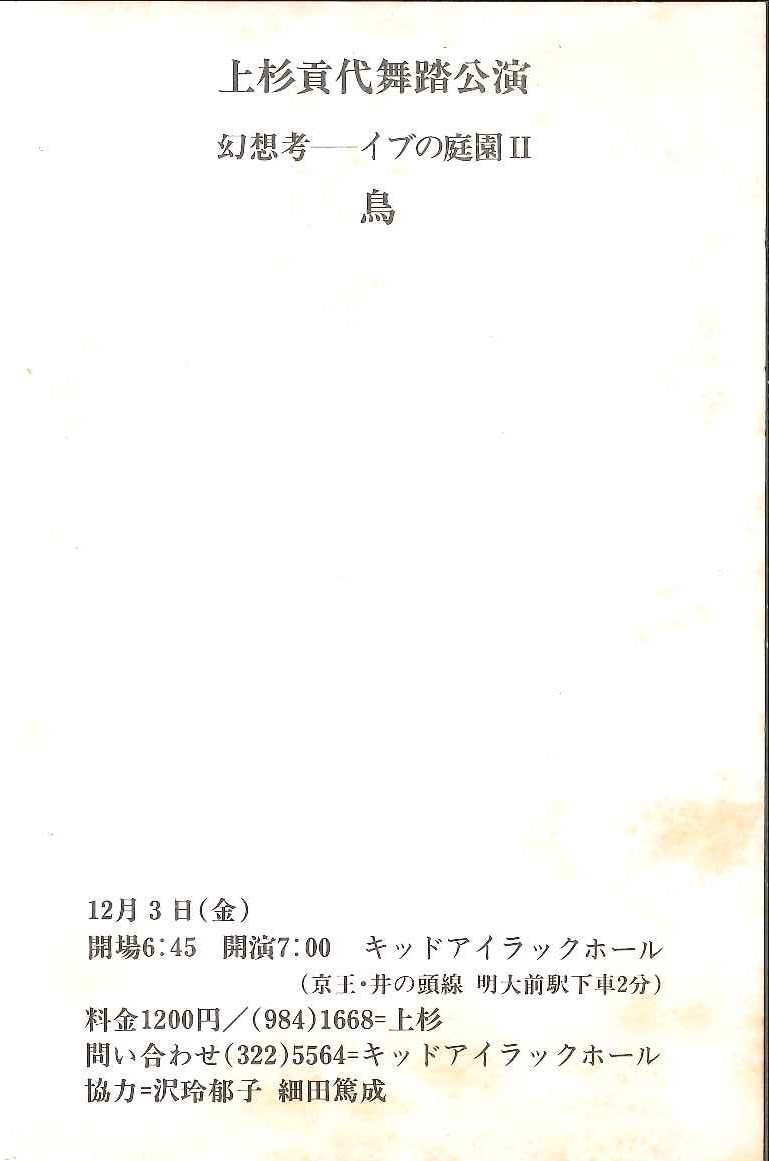
- Performer(s)
- Mitsuyo Uesugi
- Director/Choreographer
- Mitsuyo Uesugi
- Venue
- KID AILACK HALL
- Year performed
- 1982
-
The Bird – A Man who was called Bird
Premiere of "The Bird", the third piece in Furukawa's 'Anzu'ology' series.
The flyer features a quote by Leonardo da Vinci:
"The earth is moved from its position by the weight of a tiny bird resting upon it."
Act 1: Superman
Act 2: Jasmine / Kismine
Act 3: The Rabbit in the Moon
There were two performances, at 3pm and 7pm, on 31st March and 1st April.
The video includes up to the second act.
-Anzu’ology: Anzu's Altas of Animals III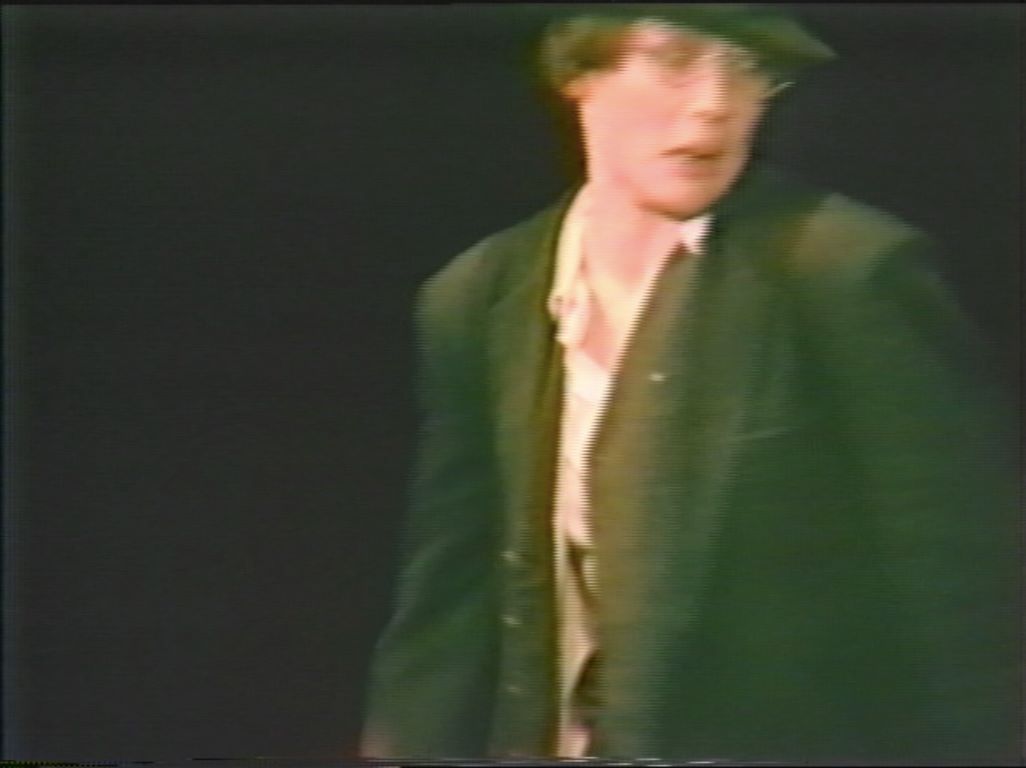
- Performer(s)
- Anzu Furukawa
- Director/Choreographer
- Anzu Furukawa
- Venue
- Jean-Jean
- Year performed
- 1990
-
Bird – Mariko Sanjo dances on the Noh Mariko
This performance was presented by Rokurobyoue Fujita, the 11th Grand Master of the FUJITA school of flute player of Noh, and was held on November 2, 1987 at the Atsuta Shrine Noh Theater. A modern dancer, Mariko Sanjo was invited to perform in the classical space of the Noh Theater created by the Japanese. "Bird" was the last piece in the program. I first performed “Bird” at Barnard College in New York City in September 1975.
Once I performed it, I got one request after another to perform it at other venues. “Bird” was performed under various conditions, from small 100-seat theaters to *Central Park’s Delacorte Theater, an open-air theater that can accommodate 2,000 people.
It was reborn each time as a new piece. In each moment, my body fought against something like an undulation that disperses and breaks. I strongly desired many times to experience that mysterious space on stage, which was indeed a different dimension, again and again. I danced the piece until the autumn of 1994. Among them, "Bird" performed at the Atsuta Shrine Noh Theater on November 2, 1987 was an unforgettable performance that "mixed tradition and deviation."
Pablo Casals who passed away at the age of 96 is said to have always played “Song of the Birds” for encore. The melody is from a folk song from his native Catalonia. It is a short simple number that is pure and transparent with a touch of bitter sweetness. As I listened to it repeatedly, I came across movements that occurred from my inner self. The will to fly regardless of whether you can…
The theme spiraled up amid repetition. Inevitable movements flowed out. A critic said "Not a single move was superfluous ... and every move was beautiful, exquisitely so."
"Bird" became Mariko Sanjo's signature piece.
(* The "Bird" danced in the Central Park's Delacorte Theater is preserved in the New York Public Library for the Performing Arts.)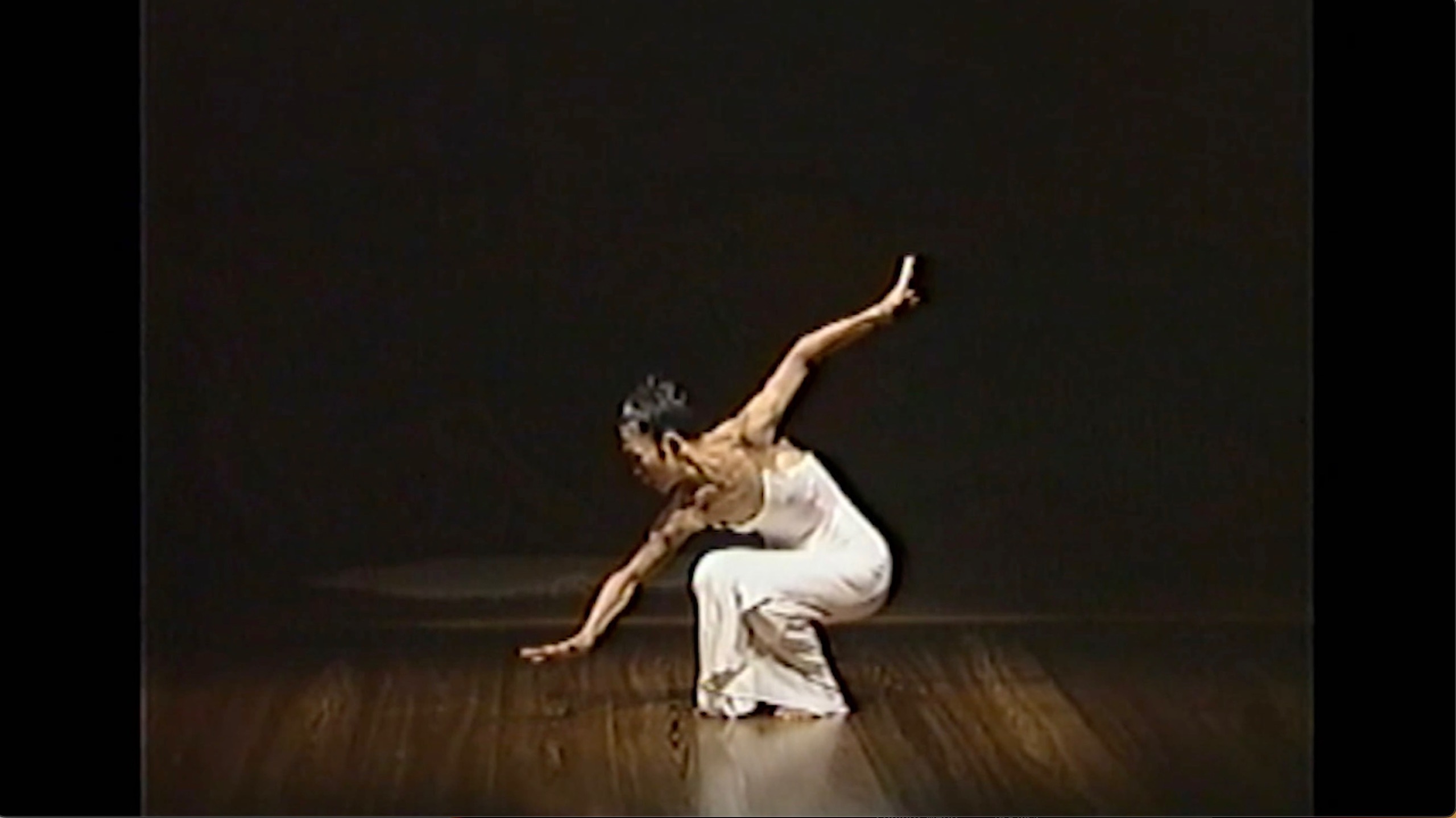
- Performer(s)
- Mariko Sanjo
- Director/Choreographer
- Mariko Sanjo
- Venue
- Atsuta Shrine Noh Theater
- Year performed
- 1987
-
Bekkō Candy
The first performance by the Hijikata Method Research Group established by Waguri Yukio, a former pupil of Hijikata Tatsumi, through weekly workshops held at Asbestos-kan at the invitation of Motofuji Akiko. Bekkō candy, known to come in many shapes, refers to the form. Waguri named the performance thus with the hope that each person would find their own form.
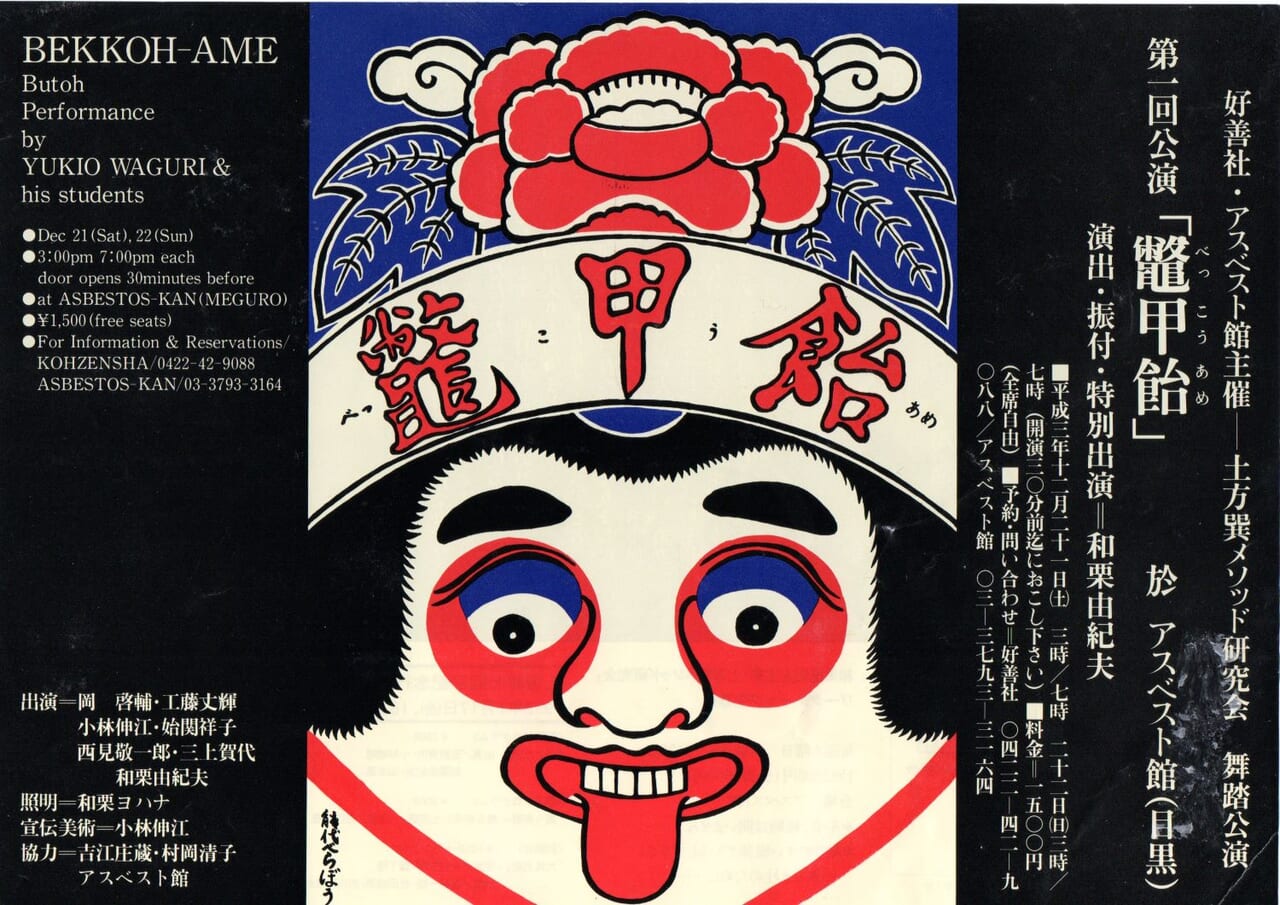
- Performer(s)
- Kozensha
- Director/Choreographer
- Yukio Waguri
- Venue
- Asbestos-kan
- Year performed
- 1991
-
Before the Dawn
"Before the Dawn", a dance of metamorphosis, where darkness melts into brightness.
Through her own transformation, Yumiko Yoshioka illuminates secrets in our bodies.
Creatures hidden in our forgotten memories joyfully start to revive.
Something grotesque yet strangely beautiful grabs our attention.
We can't help but be captivated by this strange force, a source of darkness and light.
-Premiered in Espace Culturel Bertin Poirée in Paris in April 2002. It has since been performed all over the world, including in Germany, Spain, Poland, Italy, Belarus, Portugal, the UK, the US, Canada, Mexico, Peru, Brazil, Argentina, Chile, Australia, New Zealand and South Korea.
-The video was filmed at a butoh festival in London in May 2005.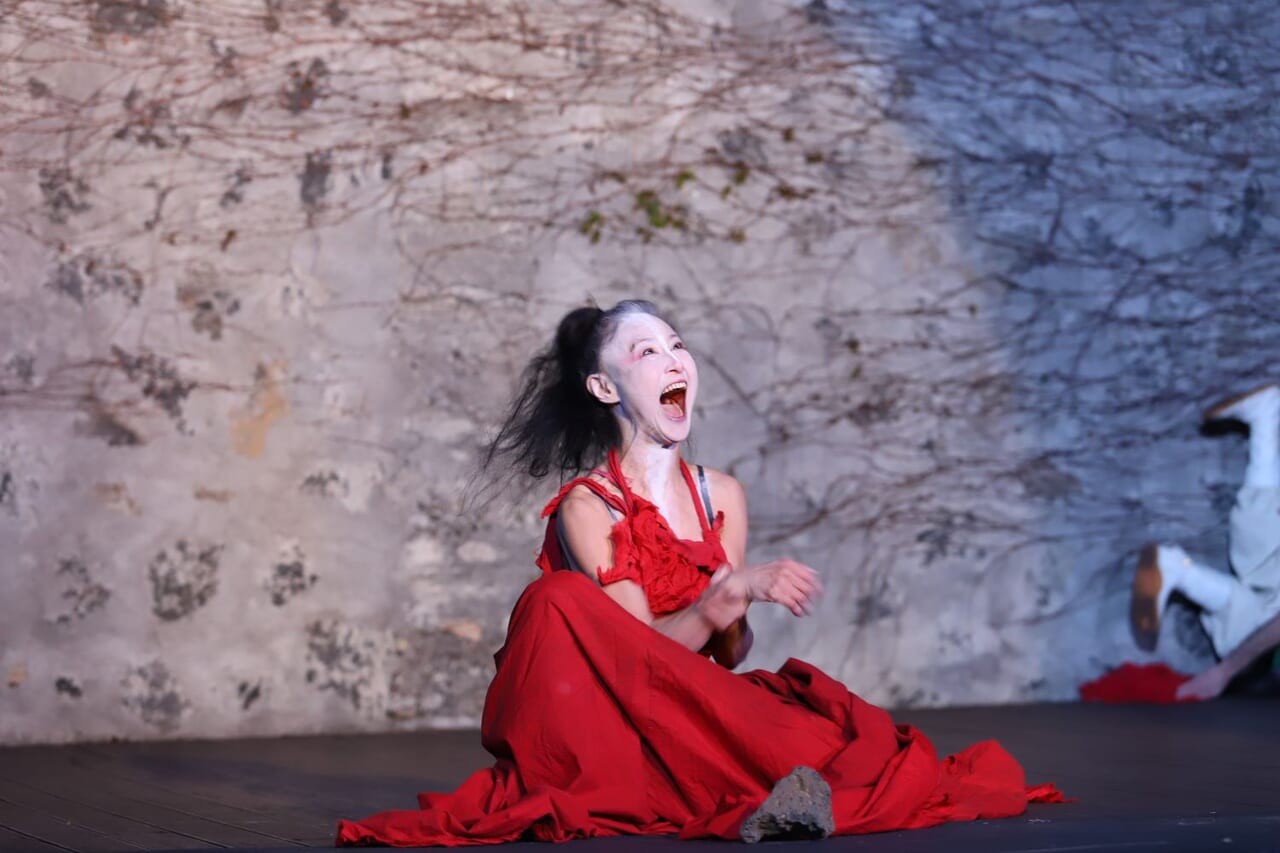
- Performer(s)
- Yumiko Yoshioka
- Director/Choreographer
- Yumiko Yoshioka
- Venue
- London
- Year performed
- 2005
-
Baroquekikizu
Footage from dance therapy sessions held at Seinan Hospital, a psychiatric hospital in Hachinohe, Aomori. From around 1980, butoh dancer Mitsutaka Ishii began holding workshops there on the invitation of photographer Mitsutoshi Hanaga. Being based in Tokyo, Ishii could not visit often, and so he taught the patients by sending practice examples by video. Due to its setting as a psychiatric hospital, this performance was held only for those involved, and all props, costumes and makeup were done by Ishii along with hospital staff.
'Baroquekikizu' was credited as dance therapy event. Later however, the film 'Mettarohozu' was credited as a butoh therapy event.
- Performer(s)
- Mitsutaka Ishii
- Director/Choreographer
- Hajime Chiba
- Venue
- Seinan Hospital (Aomori)
- Year performed
- 1981
-
Barefoot Canon
Katsuko Orita’s dance piece presented at the Midori Ishii Dance Recital. It is a group piece choreographed to Pachelbel's Canon. The choreography makes expansive use of the space and impressive gestures, with a playfulness brought in by the barefooted girls'. There is a sense of unity, moving with the music without it being an accompaniment.
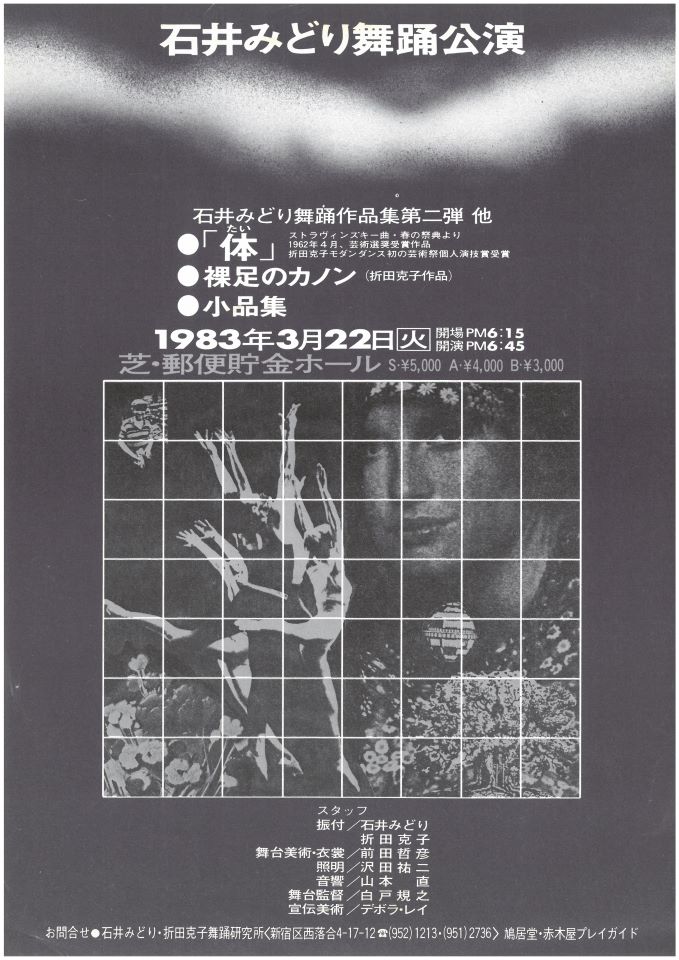
- Performer(s)
- Midori Ishii and Katsuko Orita Dance Studio
- Director/Choreographer
- Katsuko Orita
- Venue
- Tokyo Post Saving Hall
- Year performed
- 1983
-
Bar do thos grol
Tibet is full of wonders. 'Bar do thos grol' is the Tibetan name for an esoteric Buddhist scripture commonly known as the 'Tibetan Book of the Dead'. This mysterious book teaches the path for reincarnating spirits how to find their way from death to birth. Inspired by this scripture and a pilgrimage to the holy Mt. Kailash in Western Tibet in 1995, Mushimaru creates a unique, vivid mandala world of physical poetry. I must dance and travel, drink and fall in love.
- Participated in the 2nd OSAKA DANCE EXPERIENCE
- Mushimaru JAPAN TOUR '96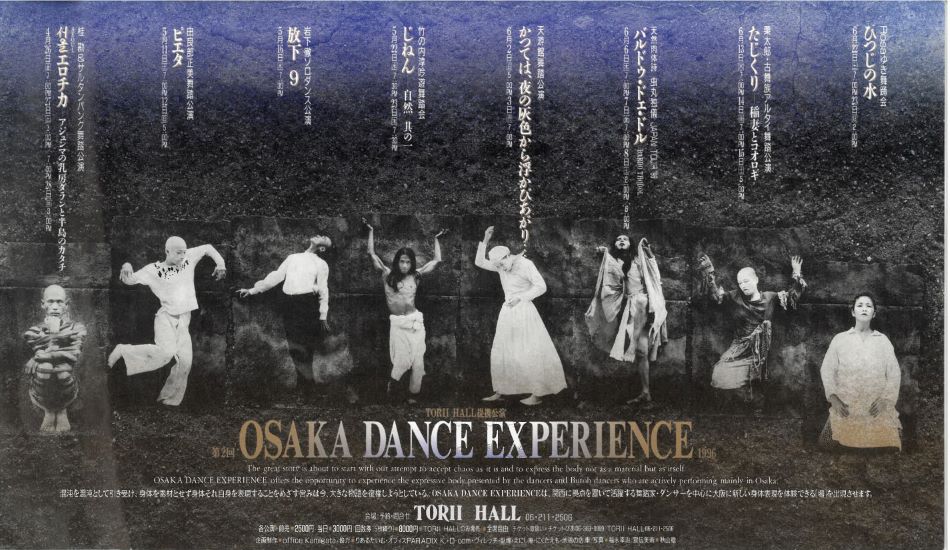
- Performer(s)
- TORII HALL
- Director/Choreographer
- Mushimaru Fujieda
- Venue
- TORII HALL
- Year performed
- 1996
